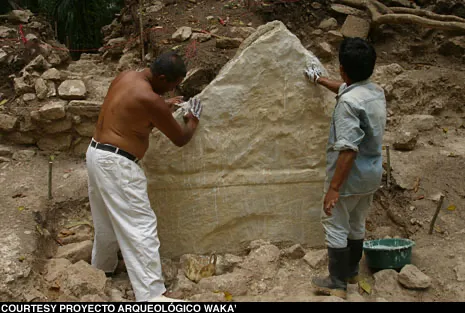Rediscovering El Perú: A Glimpse into the Maya Civilization
El Perú, also known as Waka’, stands as a testament to the grandeur of the pre-Columbian Maya civilization. Occupied from roughly 500 BC to 800 AD, this archeological site was the capital of a Maya city-state, strategically located near the banks of the San Pedro River in the Department of Petén, northern Guatemala. Approximately 60 km west of the renowned Tikal, El Perú’s significance in Maya history is undeniable.
Get your dose of History via Email
Research and Rediscovery
The rediscovery of the Maya city of Waka’ in the 1960s by oil prospectors marked the beginning of a new chapter in the understanding of Maya civilization. Documented by Harvard researcher Ian Graham in the 1970s, it wasn’t until 2003 that significant excavations began under the guidance of David Freidel of Southern Methodist University and Héctor Escobedo of the University of San Carlos.
Etymology and Naming
The site, known today as El Perú, was named upon its rediscovery in the twentieth century. However, Maya glyphs at the site revealed its ancient name to be Waka’. While both names are used, El Perú is more commonly found on maps, with literature often using the conflated name El Perú-Waka’.
Historical Significance
El Perú’s history is marked by its strategic alliances and conflicts. In 378 AD, it was the site of the first recorded meeting between Teotihuacan and the Maya, an event known as “La Entrada.” Initially allied with Tikal, Waka’ later shifted its allegiance to Calakmul, a move that would eventually lead to its downfall. The city’s trading power, bolstered by its proximity to the San Pedro River and access to vital trade routes, played a crucial role in its prominence among Maya city-states.
Population and Layout
By 400 AD, tens of thousands of people inhabited Waka’, drawn by its ideal location and trading prowess. The city boasted hundreds of buildings, including four plazas and ceremonial centers, reflecting its political and economic significance.
Recent Discoveries
Recent excavations have unearthed tombs that shed light on Maya culture, including the “Queen’s Tomb” and an elite individual’s tomb within a pyramid. These findings, along with the discovery of a strong connection between El Perú and the site of Zapote Bobal, have contributed significantly to our understanding of the Maya.
Emblem Glyphs and Monuments
The emblem glyphs and stelae of El Perú, such as Stela 15 and Stela 16, provide invaluable insights into the city’s history and its interactions with other Maya city-states and Teotihuacan. These artifacts, along with the tombs of notable figures like Lady K’abel, offer a glimpse into the complex social, political, and religious fabric of Maya society.
The Legacy of El Perú
El Perú’s legacy is a testament to the ingenuity and resilience of the Maya civilization. Despite its eventual downfall, the city’s contributions to Maya culture, trade, and politics continue to captivate researchers and enthusiasts alike. As excavations and research continue, the story of El Perú-Waka’ promises to enrich our understanding of the ancient Maya world.
El Perú today remains a challenging yet rewarding site for those interested in exploring the depths of Maya civilization. Situated within the Laguna del Tigre National Park, part of the Maya Biosphere Reserve, it offers a unique glimpse into the past, inviting visitors to step back in time and experience the legacy of the Maya.
Sources:
Wikipedia https://en.wikipedia.org/wiki/El_Per%C3%BA_(Maya_site)
Interactive Archaeology https://interactive.archaeology.org/waka/

